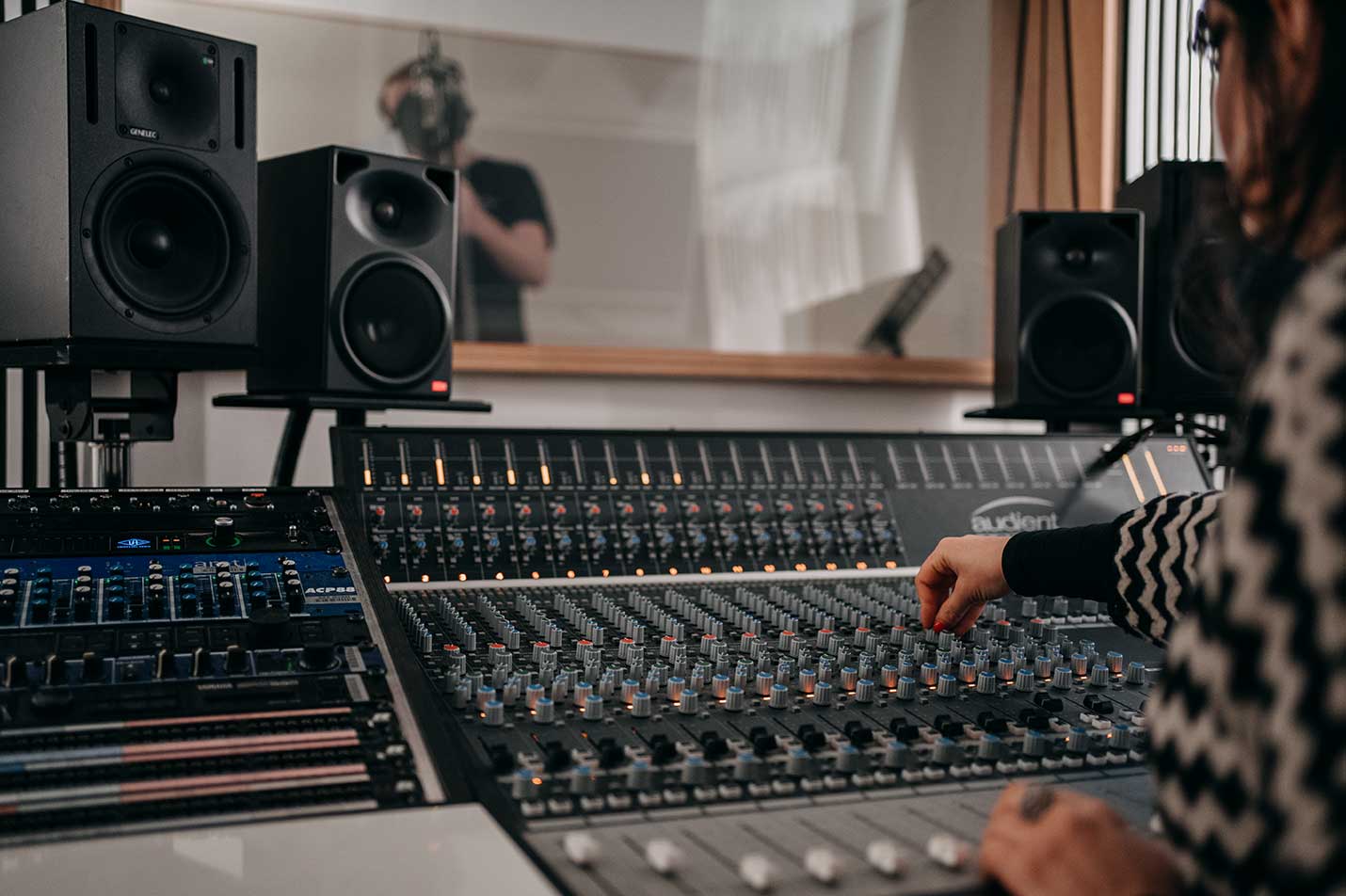Home>Production & Technology>Producer>How To Organize Sounds As A Music Producer


Producer
How To Organize Sounds As A Music Producer
Published: March 6, 2024
Learn how to organize and manage your sounds efficiently as a music producer. Discover essential tips and techniques for staying productive and creative. Become a more effective producer today!
(Many of the links in this article redirect to a specific reviewed product. Your purchase of these products through affiliate links helps to generate commission for AudioLover.com, at no extra cost. Learn more)
Table of Contents
Introduction
As a music producer, you understand the critical role that sound organization plays in your creative process. Whether you're working on a new track, collaborating with other artists, or searching for the perfect sound to complete your project, having a well-organized sound library can make all the difference. In this article, we will delve into the essential strategies and techniques for effectively organizing your sounds as a music producer. From file management systems to naming conventions and metadata, we will explore the best practices to streamline your workflow and unleash your creativity.
Sound organization is not just about tidying up your digital clutter; it's about optimizing your creative environment. By implementing a systematic approach to managing your sound library, you can save valuable time and energy that would otherwise be spent sifting through countless files and folders. Additionally, a well-organized sound library enables you to maintain a clear overview of your assets, allowing you to make informed decisions and unleash your creative potential without unnecessary distractions.
Throughout this article, we will cover various aspects of sound organization, including the importance of choosing the right file management system, creating a folder structure that suits your workflow, establishing effective naming conventions for your files, utilizing tagging and metadata to enhance searchability, and ensuring the security of your sound library through proper backup procedures.
By the end of this guide, you will have gained valuable insights into the fundamental principles of sound organization and be equipped with practical strategies to optimize your workflow as a music producer. So, let's embark on this journey to transform your sound library into a well-organized and inspiring resource that fuels your creativity and propels your music production endeavors to new heights.
Understanding the Importance of Sound Organization
Sound organization is the cornerstone of a music producer's creative process. It serves as the foundation upon which every project is built, influencing the efficiency, creativity, and overall quality of the final product. A well-organized sound library is not merely a convenience; it is a strategic asset that empowers producers to harness their creativity and maximize productivity.
One of the primary reasons why sound organization is crucial for music producers is the sheer volume of audio assets involved in the production process. From drum samples and instrument recordings to vocal tracks and sound effects, the accumulation of diverse sounds can quickly become overwhelming without a structured organizational system in place. By categorizing and cataloging these assets, producers can swiftly locate the specific sounds they need, eliminating the frustration of endless searching and enabling seamless integration into their projects.
Furthermore, sound organization directly impacts the creative flow of music production. When a producer can effortlessly access a well-curated library of sounds, they can maintain momentum and focus on the artistic aspects of their work. This streamlined workflow allows for greater experimentation, exploration, and improvisation, as the producer is not burdened by the tedious task of navigating through a disorganized collection of files.
Beyond the immediate benefits to workflow efficiency, sound organization also contributes to the overall quality and coherence of the music produced. By organizing sounds based on characteristics such as genre, instrument type, or mood, producers can make informed decisions that enhance the sonic cohesion of their compositions. This methodical approach enables them to draw from a curated selection of sounds that align with the vision of their project, resulting in a more polished and cohesive final product.
In essence, the importance of sound organization cannot be overstated. It is the backbone of a producer's creative environment, providing the essential infrastructure for efficient workflow, creative exploration, and sonic coherence. By recognizing the significance of sound organization and implementing effective strategies, music producers can unlock their full creative potential and elevate the quality of their productions.
Choosing the Right File Management System
Selecting the appropriate file management system is a pivotal decision for music producers aiming to streamline their sound organization process. The ideal system should offer a seamless and intuitive interface, robust search capabilities, and efficient file categorization features.
When evaluating file management systems, consider your specific workflow requirements and the scale of your sound library. For smaller libraries, a simple folder-based system may suffice, allowing you to organize sounds into broad categories and subcategories. However, as your library grows, a more sophisticated system, such as a digital asset management (DAM) platform, may be necessary to accommodate the expanding volume of audio assets.
DAM platforms provide advanced metadata tagging, search filters, and customizable organizational structures, empowering producers to meticulously categorize and retrieve their sound files with precision. Additionally, cloud-based DAM solutions offer the advantage of remote access and collaborative capabilities, enabling seamless collaboration with artists and collaborators from anywhere in the world.
Furthermore, the compatibility of the file management system with your digital audio workstation (DAW) is crucial. Seamless integration between the file management system and your DAW ensures a fluid transition from sound selection to project integration, minimizing disruptions to your creative flow.
It's essential to prioritize a system that supports various file formats commonly used in music production, including WAV, AIFF, MP3, and MIDI, to ensure compatibility with your diverse range of audio assets.
Additionally, consider the scalability and flexibility of the chosen system. As your sound library evolves, the file management system should adapt to accommodate the increasing volume of files and evolving organizational needs without compromising efficiency.
Ultimately, the right file management system should align with your specific workflow, offering a balance of user-friendly navigation, robust organizational tools, and seamless integration with your production environment. By carefully evaluating the features and compatibility of different file management systems, music producers can make an informed decision that enhances their sound organization process and optimizes their creative endeavors.
Creating a Folder Structure
Establishing a well-structured folder system is a fundamental step in effectively organizing your sound library. A thoughtfully designed folder structure serves as the backbone of your sound organization, providing a clear framework for categorizing and accessing your audio assets.
When crafting a folder structure, consider the overarching categories that best represent the diverse types of sounds in your library. Common categories may include "Drum Samples," "Instrumental Loops," "Vocal Tracks," "Sound Effects," and "Field Recordings." These broad categories serve as the primary divisions within your sound library, offering a starting point for further subcategorization.
Subsequently, each primary category can be further divided into subcategories that reflect specific attributes or characteristics of the sounds. For instance, within the "Drum Samples" category, subfolders could be created for "Kick," "Snare," "Hi-Hat," and "Percussion," enabling granular organization of individual sound types.
It's essential to maintain a balance between depth and simplicity in your folder structure. While it's advantageous to have a detailed subcategorization to facilitate precise sound selection, an excessively complex structure may lead to confusion and hinder accessibility. Strive for a hierarchy that is intuitive and easy to navigate, allowing for efficient retrieval of sounds during the production process.
Moreover, consider incorporating a "Favorites" or "Go-To" folder within your structure, dedicated to housing your most frequently used and essential sounds. This curated selection of go-to sounds can expedite the creative process by providing immediate access to foundational elements that define your signature sound.
As your sound library expands, periodically reassess and refine your folder structure to accommodate new additions and evolving organizational needs. Flexibility is key, and the folder structure should adapt to the dynamic nature of your creative endeavors.
By creating a well-organized and intuitive folder structure, music producers can establish a solid foundation for their sound library, enabling efficient navigation and seamless integration of audio assets into their projects. This structured approach not only enhances workflow efficiency but also empowers producers to harness the full potential of their sound library, fostering creativity and innovation in music production.
Naming Conventions for Files
Naming conventions play a pivotal role in the systematic organization of sound files within a music producer's library. A well-crafted naming convention not only facilitates efficient search and retrieval of audio assets but also contributes to the overall coherence and manageability of the sound library.
Consistency is paramount when devising naming conventions for sound files. By adhering to a standardized format, such as artist name, instrument type, and key attributes, producers can establish a uniform structure that simplifies the identification and categorization of files. For instance, a drum sample named "Kick_Dry_808_C" provides clear insights into the sound's characteristics, aiding in quick identification and selection during the production process.
Furthermore, incorporating descriptive elements into file names enhances their searchability and contextual relevance. Including descriptors such as tempo, mood, or genre in the file name enables producers to swiftly locate sounds that align with specific project requirements. For example, a piano loop named "Sad_Piano_80BPM_Am" conveys valuable information about the sound, streamlining the search process and facilitating informed decision-making during composition.
It's essential to strike a balance between informativeness and brevity in file names. While descriptive elements are valuable for contextual understanding, excessively long file names can become cumbersome and impede efficient navigation. Therefore, concise yet descriptive naming conventions are recommended to ensure clarity without overwhelming the user with excessive details.
Moreover, organizing sound files within folders based on their naming conventions can further enhance the accessibility and coherence of the library. By grouping files with similar attributes or characteristics, producers can create a logical and intuitive organizational structure that aligns with their naming conventions, simplifying the browsing and selection process.
Regularly reviewing and refining naming conventions based on evolving organizational needs and feedback from the production process is crucial. Flexibility and adaptability are key principles in maintaining an effective naming convention system, ensuring that it remains aligned with the producer's workflow and evolving creative endeavors.
In essence, naming conventions for sound files serve as a cornerstone of efficient sound organization, empowering music producers to navigate their libraries with ease, make informed creative choices, and maintain a cohesive and manageable collection of audio assets. By implementing clear, consistent, and descriptive naming conventions, producers can optimize their sound organization process and elevate the quality of their music productions.
Tagging and Metadata
Tagging and metadata management are integral components of sound organization, offering music producers powerful tools to enhance the searchability, categorization, and contextual understanding of their sound libraries. By leveraging tagging and metadata, producers can imbue their audio assets with rich, descriptive information, enabling precise retrieval and informed decision-making during the creative process.
Tagging involves the application of descriptive keywords or labels to individual sound files, allowing producers to assign specific attributes, characteristics, and associations to each asset. These tags serve as valuable identifiers, enabling producers to swiftly locate sounds based on diverse criteria such as instrument type, genre, mood, tempo, and key. By implementing a robust tagging system, producers can establish a dynamic and adaptable framework for organizing and accessing their sound library, fostering a seamless and intuitive browsing experience.
Metadata, on the other hand, encompasses a broader spectrum of descriptive information embedded within sound files. This may include details such as artist name, track title, album name, release year, and copyright information. Additionally, metadata can encompass technical specifications like sample rate, bit depth, and duration, providing valuable insights into the technical attributes of the audio assets.
Furthermore, the incorporation of custom metadata fields allows producers to tailor the informational context of their sound files to suit their specific workflow and organizational preferences. Custom metadata fields can encompass production notes, sound source details, recording techniques, and any other pertinent information that enriches the understanding and utility of the audio assets.
The strategic utilization of tagging and metadata not only streamlines the search and retrieval process but also contributes to the overall coherence and contextuality of the sound library. By associating rich descriptive information with each sound file, producers can make informed creative decisions, maintain a clear overview of their assets, and seamlessly integrate sounds that align with the vision of their projects.
Moreover, the compatibility of tagging and metadata across digital audio workstations (DAWs) and file management systems ensures seamless integration and transferability of information, fostering a cohesive and interconnected creative environment.
In essence, tagging and metadata management serve as indispensable tools for music producers, empowering them to infuse their sound libraries with rich, descriptive information that enhances searchability, contextual understanding, and creative decision-making. By harnessing the potential of tagging and metadata, producers can elevate the organization and utility of their sound libraries, unlocking new levels of creativity and efficiency in their music production endeavors.
Backing Up Your Sound Library
Backing up your sound library is not just a precautionary measure; it is an essential safeguard against potential data loss and a proactive strategy to preserve your valuable audio assets. In the realm of music production, where sound libraries serve as the lifeblood of creative endeavors, ensuring the security and integrity of these assets is paramount.
To initiate a robust backup strategy, consider leveraging a combination of onsite and offsite backup solutions. Onsite backups involve storing copies of your sound library on local storage devices such as external hard drives or network-attached storage (NAS) systems. These onsite backups provide readily accessible duplicates of your audio assets, offering a swift recovery option in the event of data loss or system failure.
In addition to onsite backups, offsite backups serve as a crucial layer of protection against unforeseen events such as theft, natural disasters, or catastrophic hardware failures. Cloud-based backup services, such as Amazon S3, Google Cloud Storage, or Dropbox, offer secure and scalable offsite storage options for music producers to safeguard their sound libraries. By replicating your audio assets in the cloud, you establish a resilient and geographically diverse backup infrastructure that mitigates the risks associated with localized data loss.
Furthermore, implementing a regular backup schedule is imperative to maintain the currency and relevance of your backup copies. Automated backup solutions, integrated with your file management system or digital audio workstation (DAW), can streamline the backup process, ensuring that new additions and modifications to your sound library are promptly replicated across your backup infrastructure.
It is equally essential to verify the integrity of your backup copies through periodic data restoration tests. By validating the recoverability of your backup data, you can instill confidence in the efficacy of your backup strategy and identify potential issues before they escalate into critical data loss scenarios.
Moreover, encryption and access control mechanisms should be employed to secure your backup data, safeguarding it against unauthorized access and data breaches. By implementing robust security measures, you fortify the confidentiality and integrity of your sound library backups, preserving the privacy of your creative assets.
In essence, backing up your sound library is a proactive investment in the continuity and security of your music production endeavors. By embracing a multi-faceted backup strategy that encompasses onsite and offsite backups, regular backup schedules, integrity validation, and stringent security measures, music producers can fortify the resilience of their sound libraries, ensuring the perpetual availability and integrity of their valuable audio assets.
Conclusion
In conclusion, the art of sound organization is a foundational pillar of success for music producers. By meticulously curating and structuring their sound libraries, producers can unlock a world of creative possibilities while streamlining their workflow. The significance of sound organization extends far beyond mere file management; it underpins the efficiency, creativity, and sonic coherence of music production endeavors.
Throughout this comprehensive guide, we have explored the essential elements of sound organization, from choosing the right file management system to crafting intuitive folder structures, implementing effective naming conventions, leveraging tagging and metadata, and establishing a robust backup strategy. Each facet of sound organization contributes to a harmonious and efficient creative environment, empowering producers to navigate their sound libraries with ease, make informed creative decisions, and safeguard their valuable audio assets.
By understanding the importance of sound organization and embracing best practices in file management, producers can transcend the challenges of digital clutter and information overload, allowing their creativity to flourish unhindered. A well-organized sound library serves as a reservoir of inspiration, enabling producers to delve into a curated collection of sounds that align with their artistic vision and project requirements.
Furthermore, the strategic utilization of tagging and metadata enhances the contextual understanding and searchability of sound files, while a robust backup strategy ensures the security and resilience of the sound library against potential data loss.
In essence, sound organization is not a mundane chore but a strategic investment in the creative process. By implementing the principles and techniques outlined in this guide, music producers can elevate the quality of their productions, maintain a clear overview of their assets, and unleash their full creative potential.
As you embark on your journey as a music producer, remember that sound organization is not a one-time task but an ongoing commitment to maintaining a dynamic and coherent sound library. Embrace the principles of consistency, adaptability, and creativity in your approach to sound organization, and witness the transformative impact it has on your music production endeavors.
With a well-organized sound library at your disposal, you are poised to embark on a creative odyssey, where every sound becomes a brushstroke on the canvas of your musical expression. Embrace the art of sound organization, and let your creativity resonate with clarity and purpose.











